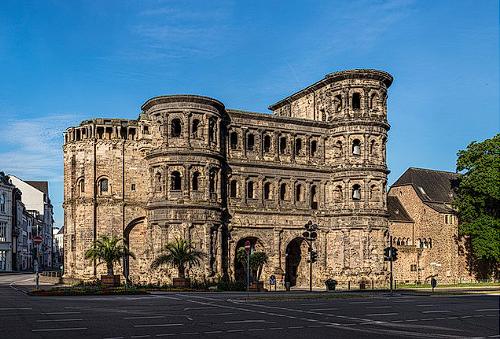Introduction to Porta Nigra
Porta Nigra, meaning “Black Gate” in Latin, is one of the most well-preserved Roman city gates in the world. Located in Trier, Germany, this monumental structure dates back to around 170 CE and stands as a testament to the architectural and engineering prowess of the Roman Empire. Over centuries, it has witnessed various historical transformations, making it an iconic landmark with a rich heritage.
Historical Significance of Porta Nigra
Porta Nigra was originally built as part of a defensive system for Augusta Treverorum, the Roman name for Trier. It served as a primary entrance to the city, controlling access and ensuring security. Due to the absence of mortar in its construction, the massive sandstone blocks were held together by iron clamps, showcasing remarkable craftsmanship.
The Name “Porta Nigra”
The name “Porta Nigra” was given during the medieval period due to the darkened color of its stones, a result of centuries of weathering. Despite its transformation over time, the gate has retained its grandeur and historical importance.

Architectural Features of Porta Nigra
The Porta Nigra is an engineering marvel, demonstrating the advanced construction techniques of the Romans. It remains one of the largest Roman gates north of the Alps, with impressive dimensions and structural integrity.
Design and Structure
The gate stands at approximately 98 feet (30 meters) in height and consists of two large towers with multiple floors. The lower sections of the structure were buried over time due to sediment accumulation, but excavations have since revealed its true scale. The massive sandstone blocks used in its construction were quarried from nearby regions and fitted together without the use of mortar.
Engineering Techniques
One of the most fascinating aspects of Porta Nigra is the way the stones were joined. The Romans used iron clamps embedded in molten lead to hold the massive blocks together, a method that has contributed to the structure’s longevity. This sophisticated engineering technique ensured that the gate could withstand the test of time, remaining largely intact for nearly two millennia.

Porta Nigra Through the Centuries
Over the centuries, Porta Nigra has undergone various changes in function and appearance, reflecting the shifting historical landscapes of Trier and the broader European region.
Medieval Transformations
In the 11th century, the gate was transformed into a church by the Greek monk Simeon of Trier. After his death, the structure was converted into the Church of Saint Simeon, which helped preserve its architectural integrity. The upper levels were modified to accommodate religious practices, and additional structures were built around it.
Restoration and Preservation
In the 19th century, under the order of Napoleon, Porta Nigra was restored to its original Roman form. The church additions were removed, and efforts were made to preserve the gate as a historical monument. Today, it stands as a UNESCO World Heritage Site, attracting thousands of visitors every year.

Tourist Attractions and Visitor Experience
Porta Nigra is a major tourist attraction in Trier, drawing history enthusiasts and architecture admirers from around the world. The site offers a unique glimpse into Roman history and provides an immersive experience for visitors.
Exploring Porta Nigra
Visitors can walk through the gate’s archways and explore the multiple floors, which offer panoramic views of Trier. Informational plaques and guided tours provide insights into the gate’s history, construction, and role in ancient Roman society.
Nearby Attractions
Trier, known as Germany’s oldest city, boasts numerous other historical sites, including the Roman Amphitheater, the Imperial Baths, and the Trier Cathedral. A visit to Porta Nigra can be complemented with a tour of these nearby attractions, enriching the overall experience of Roman heritage in the region.
Conclusion
Porta Nigra stands as a remarkable relic of the Roman Empire, showcasing exceptional engineering and historical resilience. From its origins as a city gate to its transformation into a medieval church and eventual restoration, the monument continues to captivate visitors with its storied past. As a UNESCO World Heritage Site, it remains a symbol of Trier’s rich cultural legacy and a must-visit destination for history enthusiasts worldwide.

CÁC TIN KHÁC
Mary Walton: The Forgotten Inventor Who Helped Clean Up America’s Cities
Tomb of Queen Nefertari in the Valley of the Queens, Egypt
Discover the Hypostyle Hall of the Temple of Hathor at Dendera
Venus de Losange: Unveiling the Mystery of a 20,000-Year-Old Paleolithic Icon